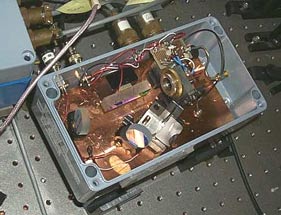
|
|
|
|
Extended Cavity Diode Lasers
|
|
|
|
|
ECDLs have been used for many years in the OFM group at NIST in order to acheive the narrow linewidths necessary for doing atomic spectroscopy. Commercial, off-the-shelf diode lasers are used in our ECDL's with wavelengths ranging from 660 nm to 1.55 mm. The lasers are first anti-reflection coated in-house, reducing the reflection at the output facet to less then one percent. The diodes are then coupled to an extended cavity which incorporates a diffraction grating as a wavelength-selective element. The extended cavity provides optical feedback to the laser, reducing the threshold current, narrowing the linewidth and providing broad tunability. Two common optical configurations, the Littrow and Littman-Metcalf schemes, are described below.
In the Littrow configuration, the grating is aligned so that the first order diffracted beam goes directly back into the laser. Typical feedback powers are about 10% of the output power. The coarse lasing wavelength is then determined by the angle of the grating with respect to the laser; wavelength tuning is accomplished by changing this angle. The zeroth order reflected beam is the output. This configuration offers the advantage that almost all of the laser light (up to 80% of the chip output) is available for the experiment. A disadvantage is that the output beam angle changes slightly as the laser is tuned with the diffraction grating angle.
In the Littman-Metcalf configuration, the output beam from the chip is aligned at grazing incidence with the grating. The first order diffracted beam is then sent to a mirror or retroreflector which relfects the beam back on itself. This reflected beam then hits the grating and the first-order diffracted beam then couples back into the laser. Tuning in this case is acheived by varying the angle of the retroreflector, which again changes the wavelength for which the laser sees optical feedback. The output is again the zeroth order reflected beam off the grating. Since the grating in this configuration does not move, the outputbeam angle does not change as the laser is tuned. However, since the light coupled back into the laser must be diffracted twice by the grating, a larger fraction of the power must be diffracted leaving less for the output.

An ECDL in the Littman-Metcalf (grazing incidence) configuration
Like most semiconductor lasers, ECDLs are affected strongly by spurious optical feedback. We typically use 40-60 dB of optical isolation at the laser output before sending the light to be used in an experiment.
John Kitching, NIST, [email protected].